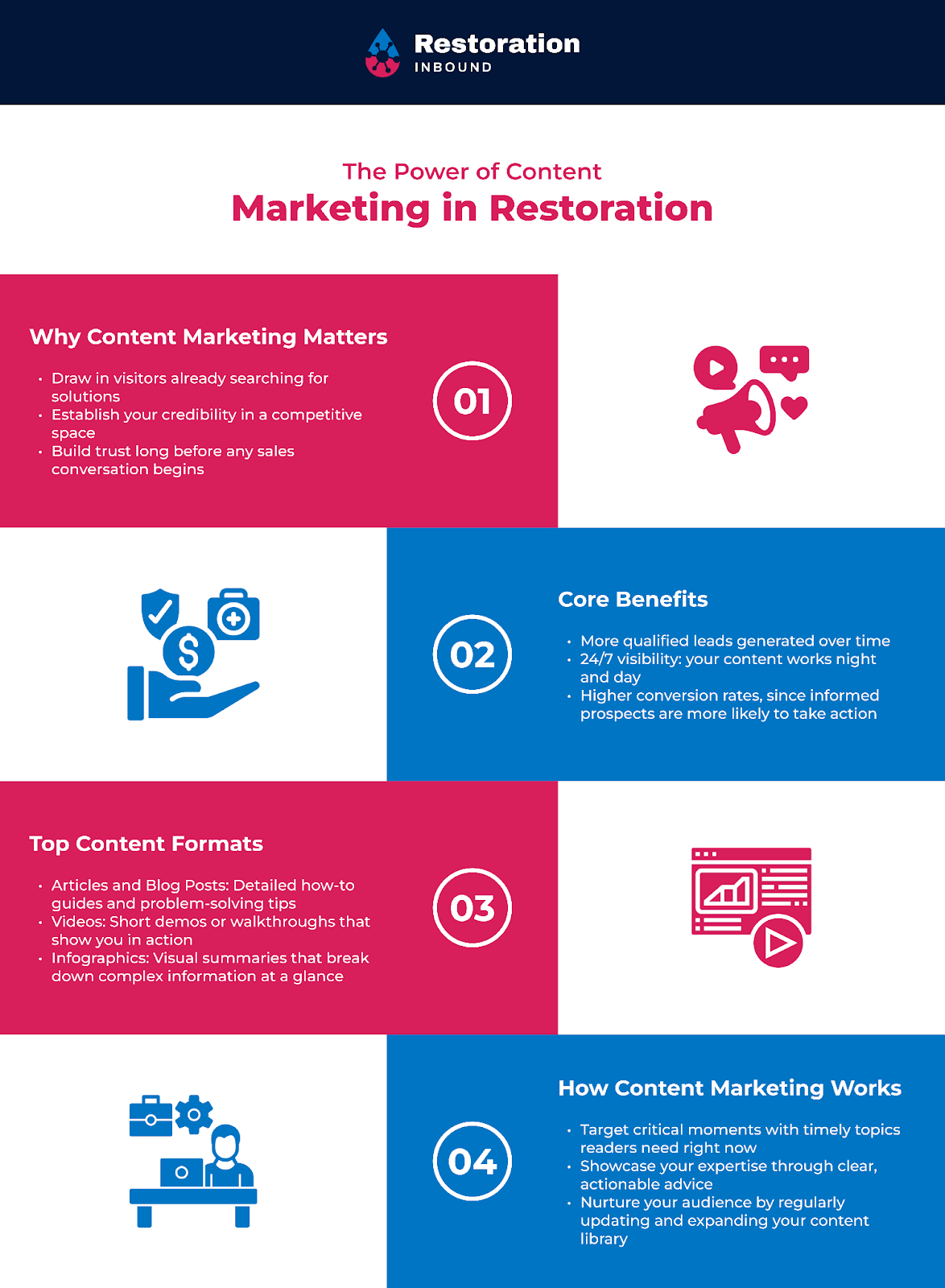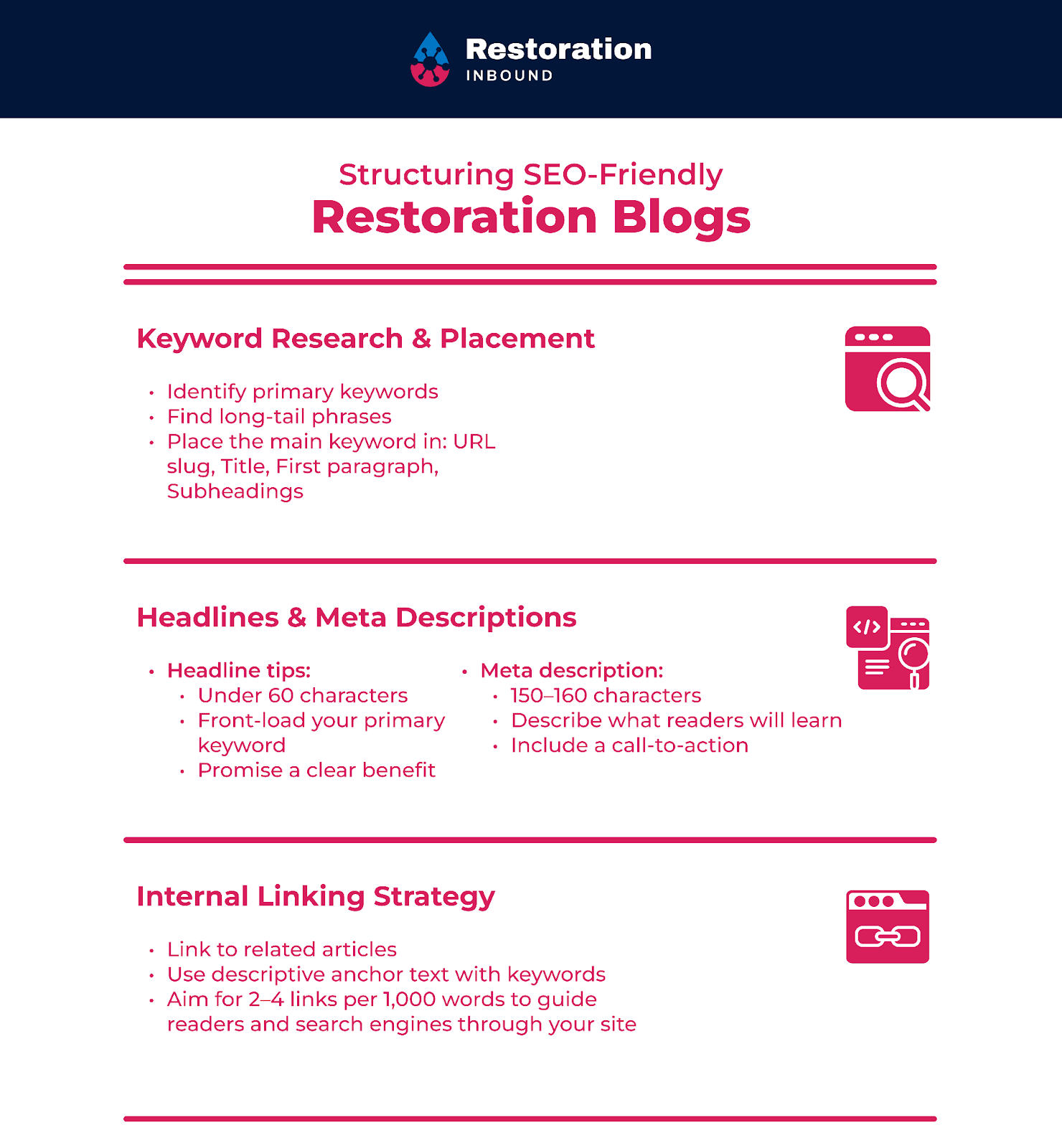Last Updated on June 18, 2025 by Hayk Saakian
Content marketing offers restoration companies a powerful way to connect with homeowners and property managers when they need help. It allows them to share clear and practical content, such as blogs, posts, videos, and guides to showcase their expertise, build trust, and attract more leads. This approach not only helps to position themselves as the go-to expert but also helps them generate more leads organically.
Understanding the Power of Content Marketing in Restoration
In this digital world, content marketing serves as a reliable way to attract new clients and build credibility. With content marketing, restoration companies can create useful and informative materials to help customers solve their immediate problems and become their restoration expert.

How Content Marketing Boosts Restoration Leads
When you create content that directly answers homeowners’ questions, such as “how can I dry out a flooded basement?” you address their needs. This kind of practical material not only captures the attention of people when they are in need, but also highlights your expertise.
Over time, readers who find value in your guides and tips return for new advice, and your regular visitors will eventually convert into qualified leads. Moreover, regular content posting also increases your site’s visibility and improves your ranking in search engines.
Blogging: The Foundation of Your Restoration Content Strategy
Blogging for restoration companies is a key part of the content plan because a clear, helpful blog teaches, reassures, and guides customers through emergencies. Here’s how to make your posts useful and SEO-friendly.

Choosing Relevant and SEO-Friendly Blog Topics
To create a strong blog, focus on SEO-friendly blog topics that matter to your audience. For example, there are several common problems that homeowners face, such as mold, flooding, or fire damage, etc. Use these ideas to create simple and helpful blogs, such as how to keep basements dry, what to do after a flood, or DIY ways to remove mold.
These types of posts help readers build trust in your services. You can also create content based on the season or your local area. During hurricane season, share tips to prevent damage, or in winter, how to deal with mold problems, etc. However, make sure your topics contain relevant keywords because it helps your blogs show up in search results.
How to Structure Blogs for SEO Success
A well-organized blog post helps boost your search rankings and keeps readers engaged. It starts with keyword research to find terms people are searching for. Once you have researched, use those keywords naturally throughout your post. Here’s how to structure your blogs for SEO
- Identify strong keywords and use them in the URL, title, intro, and subheadings.
- Write headlines under 60 characters with a clear benefit and keyword.
- Write meta descriptions around 150–160 characters with a clear description and CTA.
- Add 2–4 internal links per 1,000 words to guide both readers and search engines through your site’s content.
Leveraging Visual Content to Enhance Engagement
In the restoration industry, visual content like videos and infographics can turn uncertain customers into potential prospects by showing how you solve real problems. These contents also make technical or complex information easier to understand, which increases engagement and builds trust.
Using Videos to Demonstrate Expertise
Videos are a powerful way through which you can show your restoration expertise. They give a clear and detailed view of your process to your potential clients. Not only does this build trust, but it also explains complex steps in a visual and easy-to-follow way.
When you are planning your video content, consider this:
Step-by-step guides: Share a clear breakdown of your process. For example, when drying a flooded basement, walk viewers through each stage of the procedure step by step.
Behind-the-scenes looks: Apart from being informative, show behind-the-scenes moments from your restoration work, such as safety protocols or technicians explaining their methods and expertise.
Infographics for Simplified Education
Another effective way to simplify complex topics and make your content more engaging is through infographics. Many people, especially when they are in emergencies, do not have time to read through lengthy text, so these visuals are a great way to communicate key information quickly. To make your infographics effective, focus on one clear topic per graphic.
Use clear headings, include your brand elements, and keep the information brief but informative. A well-crafted infographic is not only easier to understand but also highly shareable, which brings more traffic from social media and increases your reach
Aligning Content with Common Customer Questions
Most people who visit a restoration website are looking for help with a specific issue. That’s why it is important to design your blog posts and web pages to directly address their concerns and questions.
Identifying Frequently Asked Questions (FAQs)
Before you start writing content, identify frequently asked questions from customers to make sure your content directly addresses their concerns. You can use several tools and resources to find out the most common queries homeowners have:
- Google Search Console: Look at the “Queries” to see what search phrases are bringing people to your site.
- Keyword research tools: Use tools like Ahrefs, SEMrush, or Moz to find related long-tail questions and search volume.
- Social listening: Check local groups on platforms like Facebook or Reddit to see what concerns homeowners are discussing.
How Answering FAQs Boosts Your Google Rankings
To improve your content’s visibility and ranking, focus on providing clear, concise answers to user questions. Google favors content that is useful and informative, so pages that effectively address user needs are more likely to rank higher in search results.
One way to increase your chances of ranking even higher is by using featured snippets and structured data. Format your content with bullet points, numbered lists, or short paragraphs, and add FAQs to help your page appear in the answer box at the top of search results.
Practical Blog Ideas Based on Common Questions
For long-tail keyword questions, turn them into comprehensive blog posts that both educate readers and help improve your search engine rankings. These in-depth articles not only answer common homeowner concerns but also increase the chances of ranking for specific search queries.
Here are some blog ideas to get started:
- What to Do Immediately After Water Damage
- Signs You Might Have Hidden Mold in Your Home
- How to File an Insurance Claim for Fire Restoration
Promoting Your Restoration Content Effectively
Once you have created several helpful blog posts and resources, it’s time to promote them. Because if your content is not reaching the right audience, your efforts may not yield the desired results. Here are some practical ways to increase your reach.
Using Social Media to Amplify Your Reach
Social media is a powerful tool to reach homeowners who may need your services. You can focus on platforms where homeowners seek guidance or tips on restoration topics, like Facebook, Instagram, and LinkedIn. To maximize your social media impact, post consistently or aim for at least two updates per week.
Make sure to write context-rich captions that briefly explain the value of your content, and use relevant hashtags and geotags to help local prospects find you. Finally, engage promptly with comments and shares to build a strong connection and demonstrate active expertise.
Encouraging Reviews Through Educational Content
Blog content can help encourage satisfied customers to leave positive reviews by providing clear, practical advice that resonates with homeowners. When readers find useful, actionable information, they are more likely to feel confident about your services and leave positive feedback.
To streamline the process, include a call-to-action at the end of your blog post, such as asking readers to leave a review if they found the guide helpful. Also, add customer testimonials to your content strategy to increase your credibility and build trust with potential clients.
Monitoring and Improving Your Content Strategy
To ensure your blogs are performing well, track performance actively, refine your approach, and invest more in what works. Here are some key performance indicators (KPIs) to track:
- Website traffic: Page views and unique visitors on each blog post
- Time on page: How long readers stay engaged with your content
- Bounce rate: The percentage who leave after viewing a single page
- Conversion rate: Percentage of visitors who submit a contact form or request a quote.
To measure the performance of your content, use tools like Google Analytics, as it provides detailed insights into traffic sources, user behavior, and conversions. You can also use SEMrush or Ahrefs to track keyword rankings, backlink growth, and competitor performance.
Partner with Restoration Inbound to Generate Leads Today!
Content marketing is a powerful tool for restoration companies to attract more leads, build trust, and establish themselves as industry experts. By regularly posting useful, easy-to-find articles, you will draw more visitors to your site, establish your team as trusted experts, and create strong relationships with clients. This approach not only enhances online visibility but also helps convert visitors into loyal clients.
Ready to boost your restoration business with proven restoration content marketing strategies?
At Restoration Inbound, we specialize in creating content plans that drive traffic, build trust, and convert leads into clients.
Contact us today to learn how we can help you generate more leads and grow your restoration business!
Frequently Asked Questions
How often should a restoration company post new blog content?
Post at least once every two weeks. If you can do it weekly, that’s great, but make sure the content is useful and accurate.
Which types of restoration topics perform best?
Focus on helpful topics like emergency advice, prevention tips, and insurance guides. These answers common questions and attract people who need help right away.
Can content marketing replace traditional advertising for restoration businesses?
Content marketing can reduce the need for ads, but a mix of both is best. Use content for steady traffic and ads for peak times or special offers.
How long does it take to see results from content marketing?
You can expect to see results in 6–12 months. You will notice small improvements first, but consistent growth takes time.
References
https://www.webfx.com/industries/home-repair/restoration-companies/lead-generation
https://restorationerp.com/resources/marketing/create-content-marketing-plan-restoration-industry/
https://blog.storychief.io/blog-content-strategy
https://www.webfx.com/content-marketing/learn/beginners-guide-how-to-promote-content
https://debutify.com/blog/reviews-and-testimonials-best-practices
https://www.linkedin.com/pulse/monitoring-your-content-marketing-performance-understanding-